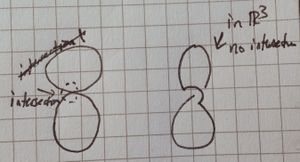Exercises:Mond - Topology - 2/Section B/Question 8
Contents
Section B
Question 8
Here is a proof that the Klein bottle can be topologically embedded in [ilmath]\mathbb{R}^4[/ilmath]. The drawing on the right below shows the image of a failed embedding of the Klein bottle in [ilmath]\mathbb{R}^3[/ilmath], [ilmath]f:K\rightarrow\mathbb{R}^3[/ilmath]. The surface has to pass through itself in order for the two ends of the cylinder to glue together as required.
To embed [ilmath]K[/ilmath] in [ilmath]\mathbb{R}^4[/ilmath] the map [ilmath]f[/ilmath] needs one further component, [ilmath]f_4:K\rightarrow\mathbb{R} [/ilmath]. You can describe [ilmath]f_4[/ilmath] by specifying its value at each point of [ilmath]K[/ilmath]. By taking care that [ilmath]f_4[/ilmath] distinguishes points on [ilmath]K[/ilmath] which have the same image under [ilmath]f[/ilmath] in [ilmath]\mathbb{R}^3[/ilmath] (i.e. in the picture), you obtain an embedding. Copy the right hand picture and write suitable values of [ilmath]f_4[/ilmath] on your copy. Your [ilmath]f_4[/ilmath] should be continuous.
Solution
| The idea here is that I use a green line's thickness to denote the value of [ilmath]f_4[/ilmath], and assume it is 0 unless specified. In this image we associate the thinner "component" (I do not want to invoke a formal definition) of the bottle with the green line shown inside of it, and we show the bulb-like component with a line representing [ilmath]f_4=0[/ilmath]. The idea is we "lift" the smaller component over the bulb where they would otherwise intersect, then lower it back down afterwards. | I sense this is the kind of thing that you're after (Mond, my tutor, has drawn a diagram like this before). We assign 0 to everything, and as the thinner component comes to intersect the "bulb", we raise it, continuously, which I've tried to convey by first raising from [ilmath]0[/ilmath] to [ilmath]\frac{1}{2} [/ilmath] then [ilmath]1[/ilmath] then back down to [ilmath]\frac{1}{2} [/ilmath] then 0.
The blue line is intended to convey the bulb stays at [ilmath]f_4=0[/ilmath] |
Lower dimensional analogy
| I want to convey understanding. This is a very similar lower-dimensional analogy, we have the figure-8 / [ilmath]\infty[/ilmath] space, and we want to make it into an embedding in [ilmath]\mathbb{R}^3[/ilmath]. To do this we first take the [ilmath]\infty[/ilmath] flat into [ilmath]\mathbb{R}^3[/ilmath] then pick one of the components of the line (it doesn't matter which) and in a small area alter it's new coordinate so it goes "over" where it'd otherwise intersect. |
Notes
References


